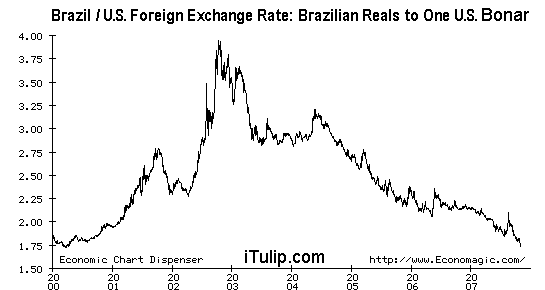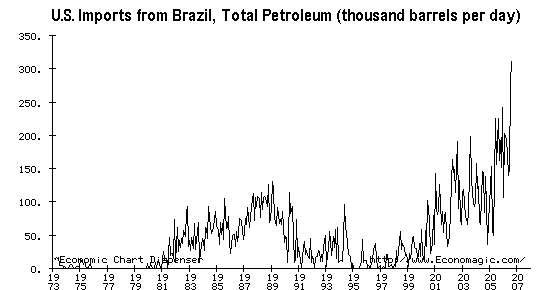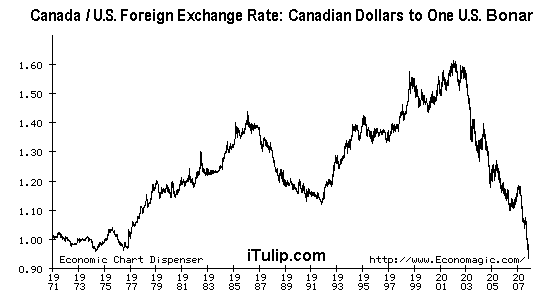Supermodel Bundchen Joins Hedge Fund Managers Dumping Dollars
Nov. 5, 2007 (Bo Nielsen and Adriana Brasileiro - Bloomberg)
Gisele Bundchen wants to remain the world's richest model and is insisting that she be paid in almost any currency but the U.S. dollar.
Like billionaire investors Warren Buffett and Bill Gross, the Brazilian supermodel, who Forbes magazine says earns more than anyone in her industry, is at the top of a growing list of rich people who have concluded that the currency can only depreciate because Americans led by President George W. Bush are living beyond their means.
Even after the dollar lost 34 percent since 2001, the biggest investors and most accurate forecasters say it will weaken further as home sales fall and the Federal Reserve cuts interest rates. The dollar plummeted to its lowest ever last week against the euro, Canadian dollar, Chinese yuan and the cheapest in 26 years against the British pound.
``We've told all of our clients that if you only had one idea, one investment, it would be to buy an investment in a non- dollar currency,'' said Gross, the chief investment officer of Pacific Investment Management Co. in Newport Beach, California, and manager of the world's biggest bond fund. ``That should be on top of the list,'' said Gross, whose firm is a unit of Munich-based insurer Allianz SE.
The dollar fell 0.8 percent last week to $1.4505, the weakest since the euro started trading in 1999. It lost 2.8 percent against the Canadian dollar to 93.51 cents and 1.8 percent versus the pound to $2.09. The Fed's U.S. Trade Weighted Major Currency Dollar index tumbled to 76.3, from 112.89 in January 2004.
BNP Paribas chief currency strategist Hans-Guenter Redeker, the most accurate foreign-exchange forecaster last quarter in a Bloomberg survey, said the dollar may drop to $1.50 per euro by year-end. The median estimate of 44 strategists surveyed by Bloomberg is for the currency to end the year at $1.43. Among those surveyed last week, the forecast ranges from $1.42 to $1.50.
When Bundchen, 27, signed a contract in August to represent Pantene hair products for Cincinnati-based Procter & Gamble Co., she demanded payment in euros,[/b] according to Veja, Brazil's biggest weekly magazine. She'll also get euros for the deal she reached last October with Dolce & Gabbana SpA in Milan to promote the Italian designer's new fragrance, The One, Veja reported. Bundchen earned $33 million in the year through June, Forbes reported in July.
``Contracts starting now are more attractive in euros because we don't know what will happen to the dollar,'' Patricia Bundchen, the model's twin sister and manager in Brazil, said in a telephone interview in September from Sao Paulo. She declined to discuss details of the arrangements last week, as did Anne Nelson, Bundchen's agent in New York at IMG Models.
AntiSpin: Just when we thought the bonar, the official currency of the United Banana Republic of America (UBRA), formerly the United States of America's dollar, couldn't sink any lower, today we learn even supermodels, not a group usually associated with currency market savvy, are jumping ship. A glance at the exchange rate between the Brazilian real and the bonar shows you don't have to be a supermodel to see why.

To the uninitiated, the chart above shows that fewer and fewer reals are needed to buy a bonar, which means that more bonars are needed to buy a real, which means the bonar is getting weaker. If this keeps up, we'll see real/bonar parity, a blow to prestige that was recently delivered by the Canadian dollar and with similar admonitions of shock stateside, albeit without a Canadian supermodel rubbing it in.
If you are a new arrival to iTulip, you are wondering why we use the term bonar. For one thing, it's much less clunky than "The Currency Formerly Known as the US Dollar." But we refuse to acknowledge that this, this–thing–is the currency of a great nation.
The bonar is like the US dollar, only smaller, if you know what I mean.
If you want to know why the bonar is so flaccid, you could do worse than take a trip to Brazil. Once a banana republic itself, Brazil has been getting its act together and is now a major exporter of goods to the US, especially oil. The oil trend is not hard to spot, so to speak.

The pattern repeats. Other exporters of natural resources that the United Banana Republic of America (UBRA) needs to function includes our neighbor Canada, whose currency–not coincidentally–is also surging. In fact, the Canadian dollar closed today at 107.18 bonars for the first time in, oh, 57 years.

Today the bright folks at minyanville said:
What makes this news is that everyday experience for billions of the world's people is not what's in the heads of millions of "smart" and "informed" North American investors. The Brazilian real has been appreciating as the US desperately imports Brazilian oil but we think, How dare a "stupid" supermodel dis the almighty dollar.
The US government has but one policy tool left to keep the US economy afloat: currency depreciation. "Even" Bundchen understands this.
Meanwhile, the latest stupid pet trick of modern finance is revealed by a contact who runs a fixed income fund in the high ten figures. He tells us that one of the key motivations for creating funds of SIV funds is not to bury the securitized debt detritus from the housing bubble but–get this–to bury the detritus from the technology stock bubble era. Really stinky old garbage from 2001 to 2002 that no one wants to see priced. Implies that SIV funds of funds are pools of pools of garbage.
And you thought the dot com bubble was ancient history. But this makes perfect sense to us. Friends in VC industry on the left coast have confided that the dot com bubble never really ended. We weren't sure what they meant until we heard this. How can nearly six trillion bonars in fictitious value vanish into money heaven with only a four month recession in early 2001 and a puny bear market in stocks as we saw 2001 to 2002?
As it turns out, trillions of bonars in as yet squatting as unmarked losses in SIVs. Only about a trillion or so was written down. The rest is hidden in these "structured" (read: made so complex auditors can shrug, pass them, and still maintain plausible deniability) funds along with the fresher detritus from the housing bubble.
Then there's this tidbit from Garth Friensen writing for Institutional Investor Alpha magazine. In the Oct. issue he argues that bond securitization has created a heretofore impossible scenario: credit crisis without defaults. We amplify his point: a credit crisis before good old fashioned defaults.
Those are coming, which is why the bonar is tanking. The only reason it hasn't fallen even more is that there remains the artifice of faith that the fallen Humpty Dumpty structured credit market can be reassembled.
Bundchen a dummy? Maybe she ought to be running the SEC.
(Story posted by JK, AntiSpin by Eric Janszen)
Nov. 5, 2007 (Bo Nielsen and Adriana Brasileiro - Bloomberg)
Gisele Bundchen wants to remain the world's richest model and is insisting that she be paid in almost any currency but the U.S. dollar.
Like billionaire investors Warren Buffett and Bill Gross, the Brazilian supermodel, who Forbes magazine says earns more than anyone in her industry, is at the top of a growing list of rich people who have concluded that the currency can only depreciate because Americans led by President George W. Bush are living beyond their means.
 |
``We've told all of our clients that if you only had one idea, one investment, it would be to buy an investment in a non- dollar currency,'' said Gross, the chief investment officer of Pacific Investment Management Co. in Newport Beach, California, and manager of the world's biggest bond fund. ``That should be on top of the list,'' said Gross, whose firm is a unit of Munich-based insurer Allianz SE.
The dollar fell 0.8 percent last week to $1.4505, the weakest since the euro started trading in 1999. It lost 2.8 percent against the Canadian dollar to 93.51 cents and 1.8 percent versus the pound to $2.09. The Fed's U.S. Trade Weighted Major Currency Dollar index tumbled to 76.3, from 112.89 in January 2004.
BNP Paribas chief currency strategist Hans-Guenter Redeker, the most accurate foreign-exchange forecaster last quarter in a Bloomberg survey, said the dollar may drop to $1.50 per euro by year-end. The median estimate of 44 strategists surveyed by Bloomberg is for the currency to end the year at $1.43. Among those surveyed last week, the forecast ranges from $1.42 to $1.50.
When Bundchen, 27, signed a contract in August to represent Pantene hair products for Cincinnati-based Procter & Gamble Co., she demanded payment in euros,[/b] according to Veja, Brazil's biggest weekly magazine. She'll also get euros for the deal she reached last October with Dolce & Gabbana SpA in Milan to promote the Italian designer's new fragrance, The One, Veja reported. Bundchen earned $33 million in the year through June, Forbes reported in July.
``Contracts starting now are more attractive in euros because we don't know what will happen to the dollar,'' Patricia Bundchen, the model's twin sister and manager in Brazil, said in a telephone interview in September from Sao Paulo. She declined to discuss details of the arrangements last week, as did Anne Nelson, Bundchen's agent in New York at IMG Models.
AntiSpin: Just when we thought the bonar, the official currency of the United Banana Republic of America (UBRA), formerly the United States of America's dollar, couldn't sink any lower, today we learn even supermodels, not a group usually associated with currency market savvy, are jumping ship. A glance at the exchange rate between the Brazilian real and the bonar shows you don't have to be a supermodel to see why.

To the uninitiated, the chart above shows that fewer and fewer reals are needed to buy a bonar, which means that more bonars are needed to buy a real, which means the bonar is getting weaker. If this keeps up, we'll see real/bonar parity, a blow to prestige that was recently delivered by the Canadian dollar and with similar admonitions of shock stateside, albeit without a Canadian supermodel rubbing it in.
If you are a new arrival to iTulip, you are wondering why we use the term bonar. For one thing, it's much less clunky than "The Currency Formerly Known as the US Dollar." But we refuse to acknowledge that this, this–thing–is the currency of a great nation.
The bonar is like the US dollar, only smaller, if you know what I mean.
If you want to know why the bonar is so flaccid, you could do worse than take a trip to Brazil. Once a banana republic itself, Brazil has been getting its act together and is now a major exporter of goods to the US, especially oil. The oil trend is not hard to spot, so to speak.

The pattern repeats. Other exporters of natural resources that the United Banana Republic of America (UBRA) needs to function includes our neighbor Canada, whose currency–not coincidentally–is also surging. In fact, the Canadian dollar closed today at 107.18 bonars for the first time in, oh, 57 years.

Today the bright folks at minyanville said:
"You know, although we haven't formally backtested this, we're going to go out on a limb and suggest that of all the potential contrarian strategies now available to the modern day investor, taking the opposite side of the macro views of a supermodel probably ranks near the top in terms of successful contrarian investment strategies."
Rather than a "macro view" hers is the view out the window. The US Treasury Dept. weather forecasters note years of bonar blue sky days behind us and call for more ahead. But she's looking out the window and–guess what?– it's raining cats and dogs and has been for four years. So who's stupid, the Brazilian supermodel or the North Americans who keep accepting their government's depreciated currency in exchange for their labor?What makes this news is that everyday experience for billions of the world's people is not what's in the heads of millions of "smart" and "informed" North American investors. The Brazilian real has been appreciating as the US desperately imports Brazilian oil but we think, How dare a "stupid" supermodel dis the almighty dollar.
The US government has but one policy tool left to keep the US economy afloat: currency depreciation. "Even" Bundchen understands this.
 |
And you thought the dot com bubble was ancient history. But this makes perfect sense to us. Friends in VC industry on the left coast have confided that the dot com bubble never really ended. We weren't sure what they meant until we heard this. How can nearly six trillion bonars in fictitious value vanish into money heaven with only a four month recession in early 2001 and a puny bear market in stocks as we saw 2001 to 2002?
As it turns out, trillions of bonars in as yet squatting as unmarked losses in SIVs. Only about a trillion or so was written down. The rest is hidden in these "structured" (read: made so complex auditors can shrug, pass them, and still maintain plausible deniability) funds along with the fresher detritus from the housing bubble.
Then there's this tidbit from Garth Friensen writing for Institutional Investor Alpha magazine. In the Oct. issue he argues that bond securitization has created a heretofore impossible scenario: credit crisis without defaults. We amplify his point: a credit crisis before good old fashioned defaults.
Those are coming, which is why the bonar is tanking. The only reason it hasn't fallen even more is that there remains the artifice of faith that the fallen Humpty Dumpty structured credit market can be reassembled.
Bundchen a dummy? Maybe she ought to be running the SEC.
(Story posted by JK, AntiSpin by Eric Janszen)


Comment